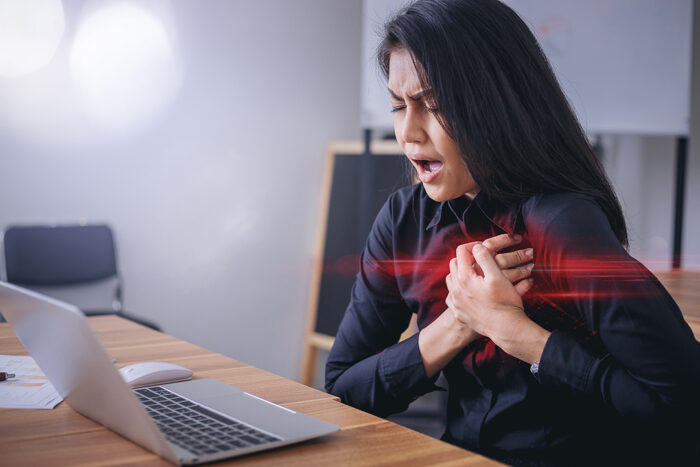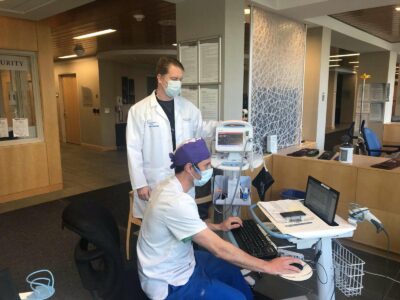
Heart disease is the number one killer of women in the United States. But the good news is that it’s 80 percent preventable.
The statistics are staggering: According to the American Heart Association, heart disease is the number one killer of women in the United States. And heart disease and stroke cause one in three deaths among women each year–more than all cancers combined.
Yet heart disease continues to be considered a “mostly male health issue.” Because of this misconception, women who are experiencing signs of a heart attack often don’t seek the immediate, life-saving care they need. In fact, it is common for women to wait more than six hours after first feeling the symptoms of a heart attack before going to the ER. Often, they believe they are experiencing nonlife-threatening conditions like acid reflux, the flu or normal aging. As a cardiologist, I encourage women to think about their heart health, and the heart health of the women they love, as the actions you take now could save your life.
Know The Symptoms
We’ve all seen the crushing left-sided chest pain of a heart attack that’s dramatized on TV. It’s important to know, though, that women don’t experience heart attack symptoms the same way men do. Women can feel chest pain, but more often will feel a little chest tightness or some weakness, shortness of breath or pain anywhere in the upper body, like the back of the neck or jaw. Indeed, chest pain is absent in 43% of women having a heart attack.
Women, particularly older diabetic women, tend to have more vague symptoms that make it difficult to tell what exactly is going on. These symptoms could be as common as weakness or fatigue. This is a primary reason why women delay seeking treatment or calling 911 and why there is sometimes a delay in doing an EKG or cardiology consultation for women. It is important for women to know the signs and to seek help immediately for any troubling symptoms.
Get Screened
As women, we know to schedule regular mammograms, but we continue to lag behind men in getting screened for heart disease. According to the AHA, almost two-thirds (64%) of women who die suddenly from coronary heart disease exhibit no previous symptoms. This is why physicians and cardiologists stress the importance of regular cardiac screening for women.
Lower Your Risk
Lifestyle changes can profoundly affect heart health in women. According to the AHA, nearly 80% of cardiac events can be prevented, yet cardiovascular diseases continue to be a woman’s greatest health threat. To help combat this threat, consider the following recommendations:
• Get moving: We recommend 150 minutes of aerobic exercise a week–that’s 30 minutes, five days a week. Anything that gets you moving counts, so walk, take the stairs or park far away and walk to the store. Then, as your body is able to accept a higher level of activity, move more. Exercise also helps with stress.
• Avoid sitting for long periods: A sedentary lifestyle is dangerous for overall health. If you’re sitting at your desk all day, set a timer every hour as a reminder to get up and get moving.
• Adjust your diet: When you start exercising, the endorphin release will make you motivated to make better food choices. Avoid processed foods and stick to natural, whole foods. We recommend a Mediterranean diet for optimal heart health.
• Get annual checkups: Regular checkups should start at age 40 or sooner if you have a family history of diseases. Once you know your numbers, your doctor can better guide you on how to reduce your chances of having a heart attack.
• Stop smoking: According to the AHA, smoking increases the risk of heart disease and stroke by two to four times. Also, women who smoke have a 25% higher risk of developing heart disease as compared to men who smoke. Discuss a smoking cessation plan with your doctor and kick the smoking habit.
While it’s frightening to know that someone dies of a heart attack every 42 seconds, this statistic is something our team of highly skilled cardiologists and heart health specialists are working hard to reverse. Relying on evidence-based research, and using the most advanced equipment and techniques, we can provide world-class cardiovascular care to women and men here in Westchester County, close to home. Know the symptoms of heart disease, get screened and practice prevention.



 By Beth Besen
By Beth Besen Barbara Daniel, Local Dog Walker: Dog hikes can be enjoyable in every season when you’re prepared. My favorite winter hiking tool is Yak-Traks. These ‘snow tires’ or ‘chains’ for shoes make it possible to navigate over, or through, snow or icy surfaces. Many local stores sell them or similar brands.
Barbara Daniel, Local Dog Walker: Dog hikes can be enjoyable in every season when you’re prepared. My favorite winter hiking tool is Yak-Traks. These ‘snow tires’ or ‘chains’ for shoes make it possible to navigate over, or through, snow or icy surfaces. Many local stores sell them or similar brands.